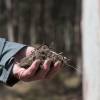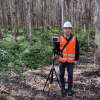
Plantation thinning for carbon, construction timber and innovation
Posted 13 February 2023
Managing trees PFT Tree Alliance
Plantation thinning may not be new in the forestry sector, which has been thinning to improve tree growth and vigour for years. But the operations being carried out by Forico in Tasmania’s northwest are racking up the benefits, continuing the development of forestry-based carbon methodology, growing construction timber, and pushing innovation boundaries.
Forestry and carbon
Forico is believed to be one of the first Australian forestry and asset management companies to register plantation forestry projects with the Clean Energy Regulator’s Emissions Reduction Fund (ERF). The company uses an Enterprise Valuation Model to identify operations with the potential to add value across its managed estate. In early 2022, modelling predicted that thinning trees between nine and twelve years of age would produce more substantial growth, suitable for sawlogs and the building timber or engineered wood products of the future.
Further investigation by Strategic Planning Manager Steven Butt and Sustainability Manager Simon Cook identified the opportunity to register operations under Schedule 2 of the ERF’s Plantation Forestry Method. This would generate carbon credits, the trees capturing more carbon in the resulting extra ten years of growth than would have been captured on a shorter rotation. Figures indicated that an extra hundred tonnes per hectare of carbon will be drawn down from the atmosphere and stored.
‘We’ve all known for a long time that thinning trees creates results in greater carbon capture in the long term, with greater height and volume in the crop, better access to light and water and capacity to photosynthesise,’ says Darren Herd, Forico’s General Manager of Plantation Performance. ‘What’s new here is the opportunity to convert a hardwood crop from short to long rotation, while creating additional Natural Capital value in more carbon sequestration, with the costs supported by registering for Australian Carbon Credit Units.’
Specialist Harvest Machinery
The project was registered with the ERF in March 2022 and began in July, overseen by Forico’s Operations Forester Roger Ambrose. Forico appointed Tasmanian contractor Casegrande Lumber, whose Principal is Paul Morgan. Both he and Ambrose have extensive experience in commercial thinning operations.
Casegrande was equipped with harvesters designed to rotate within their own footprint reducing the likelihood of damage to trees, and a long boom allowing for greater reach. This reduces the need for ‘outrows’, when an entire row of trees is removed to allow passage, and results in less traffic across the site, reduced impact on soil and productivity, and fewer windrows, reducing the potential for storm damage.
Forestry and Innovation
Working with Private Forests Tasmania (PFT) and researcher Mauricio Acuna from the University of the Sunshine Coast (USC), Forico also facilitated a trial as part of the Wood Supply Co-investment Program supported by PFT, relating to Light Detection and Ranging (LiDAR) sensing technology.
Results from two plantation plots were compared, a control plot in which the harvesting operator selected trees for extraction, and a plot in which trees were marked for harvest in a manner mimicking selection by sensing technology. While results are still being collated, it is hoped that LiDAR will prove to be a highly effective means of streamlining thinning operations.
‘There’s a distinct difference in the appearance of the plantations and the quality of the outcome,’ says Forico’s Harvest Operations Manager for the Northwest, Mark Pearce.
Lumber for the long-term
With a view to long-term planning and diversification, growing plantation hardwood for a longer rotation aligns with one of Forico’s strategic goals, namely the investigation into downstream processing. The sawlogs and potential for lumber and engineered wood products from thinning operations ultimately addresses the emerging critical shortage of structural timber in Australia.
Background
Forico is Tasmania’s largest private asset-management company, engaged on behalf of the investors of The Tasmanian Forest Trust managed by investment fund manager New Forests. Forico manages 89,362 hectares of globally certified plantation for sustainable wood fibre production, and 77,552 hectares of natural forest areas, which is not harvested for commercial purposes but conserved by the company for biodiversity and cultural value.
Forico strongly believes that forest products can make a positive contribution to the mitigation of climate change and the transition to a circular economy which replaces single-use plastics and carbon-intensive industries with fully renewable resources.
Darren Herd, General Manager Plantation Performance, Forico
M: +61 419 376 796 E: darren.herd@forico.com.au
Fiona Stocker, Communications Advisor, Forico
M: +61 497 420 550 E: fiona.stocker@forico.com.au





